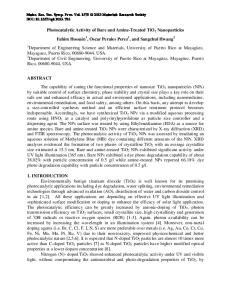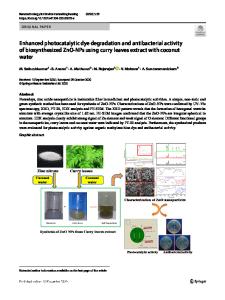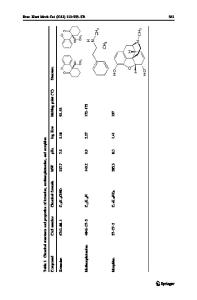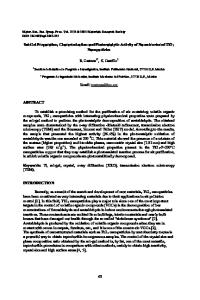Antibacterial and photocatalytic activity of TiO 2 and ZnO nanomaterials in phosphate buffer and saline solution
- PDF / 567,191 Bytes
- 9 Pages / 595.276 x 790.866 pts Page_size
- 39 Downloads / 347 Views
METHODS AND PROTOCOLS
Antibacterial and photocatalytic activity of TiO2 and ZnO nanomaterials in phosphate buffer and saline solution Alan Man Ching Ng & Charis May Ngor Chan & Mu Yao Guo & Yu Hang Leung & Aleksandra B. Djurišić & Xu Hu & Wai Kin Chan & Frederick Chi Chung Leung & Shuk Yin Tong
Received: 29 November 2012 / Revised: 26 March 2013 / Accepted: 31 March 2013 / Published online: 10 May 2013 # Springer-Verlag Berlin Heidelberg 2013
Abstract We studied antibacterial and photocatalytic activity of anatase TiO2 and ZnO in phosphate buffer and saline solution. We found that the different anions in the suspension medium (chloride and phosphate) significantly affected the following suspension properties: the stability of nanoparticle suspension, the release of metal ions from the nanoparticles, and the production of the reactive oxygen species by the nanoparticles. As a result, antibacterial activity and photocatalytic dye degradation were also affected. However, the effect of the suspension medium was different for ZnO and TiO2. Obtained results are discussed. Keywords Photocatalysis . Antibacterial activity . ZnO . TiO2
A. M. C. Ng : M. Y. Guo : Y. H. Leung : A. B. Djurišić (*) Department of Physics, The University of Hong Kong, Pokfulam Road, Hong Kong, Hong Kong e-mail: [email protected] A. M. C. Ng : X. Hu : S. Y. Tong Department of Physics, South University of Science and Technology of China, Shenzhen, China C. M. N. Chan : F. C. C. Leung School of Biological Sciences, The University of Hong Kong, Pokfulam Road, Hong Kong, Hong Kong W. K. Chan Department of Chemistry, The University of Hong Kong, Pokfulam Road, Hong Kong, Hong Kong
Introduction Antibacterial (Brayner et al. 2006; Cho et al. 2004; Cushnie et al. 2009; Dastjerdi and Montazer 2010; Foster et al. 2011; Gogniat et al. 2006; Goulhen-Chollet et al. 2009; Huang et al. 2000; Kikuchi et al. 1997; Kiwi and Nadtochenko 2004; Li et al. 2011, 2008; Maness et al. 1999; Marugán et al. 2010; Nadtochenko et al. 2005; Song et al. 2010) and photocatalytic (Fujishima et al. 2008; Guo et al. 2011a, b; Ishibashi et al. 2000; Marugán et al. 2010) activity of metal oxide nanomaterials has been extensively studied. Materials typically considered for these applications are TiO2 and ZnO (Li et al. 2008). Commonly accepted mechanism of antibacterial action of these materials is the production of reactive oxygen species (ROS) (Dastjerdi and Montazer 2010; Foster et al. 2011; Li et al. 2008), although there have been conflicting reports on the type of ROS responsible for the antibacterial action (OH• radicals vs. hydrogen peroxide) (Cho et al. 2004; Foster et al. 2011; Kikuchi et al. 1997; Li et al. 2008). In case of ZnO, release of Zn2+ can also contribute to the toxicity of ZnO nanoparticles (Li et al. 2008; Song et al. 2010), and it was even proposed to be a dominant mechanism of toxicity of ZnO (Song et al. 2010). Damage to the cell membranes upon the exposure to light in the presence of metal oxide nanoparticles is well documented (Brayner et al. 2006; Foster et al
Data Loading...











